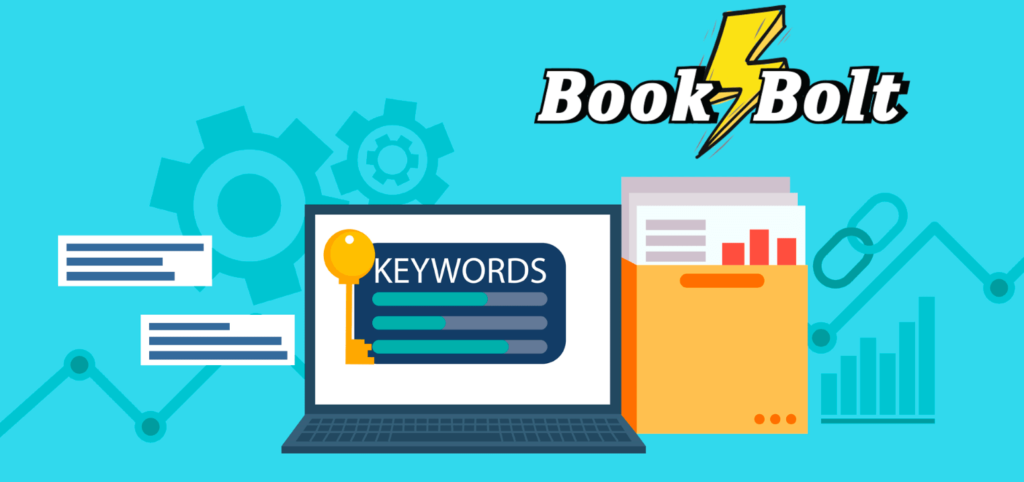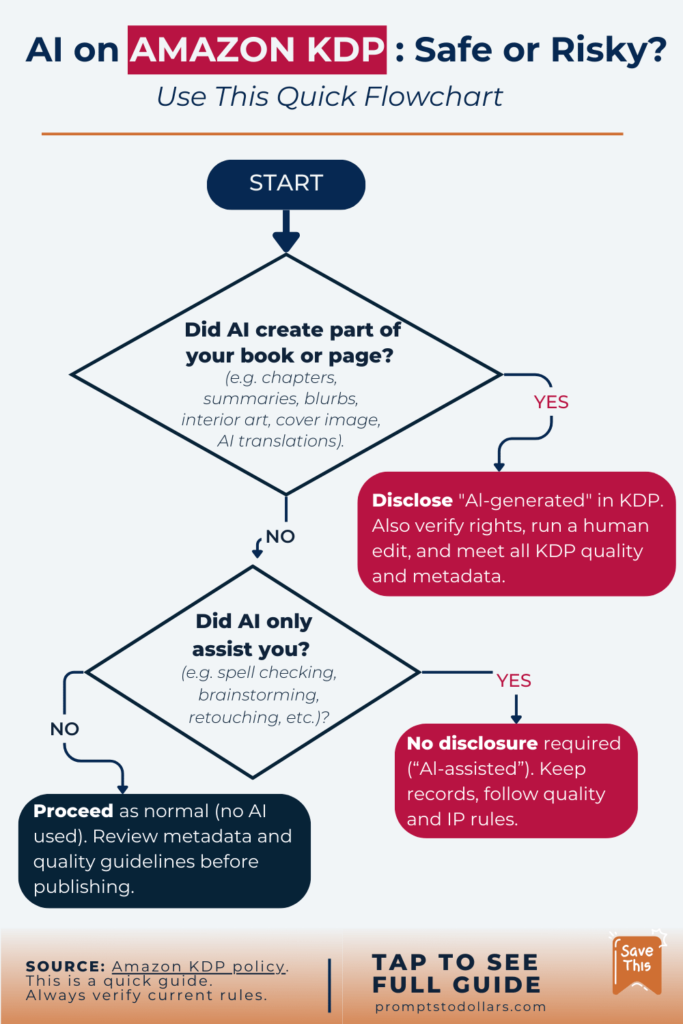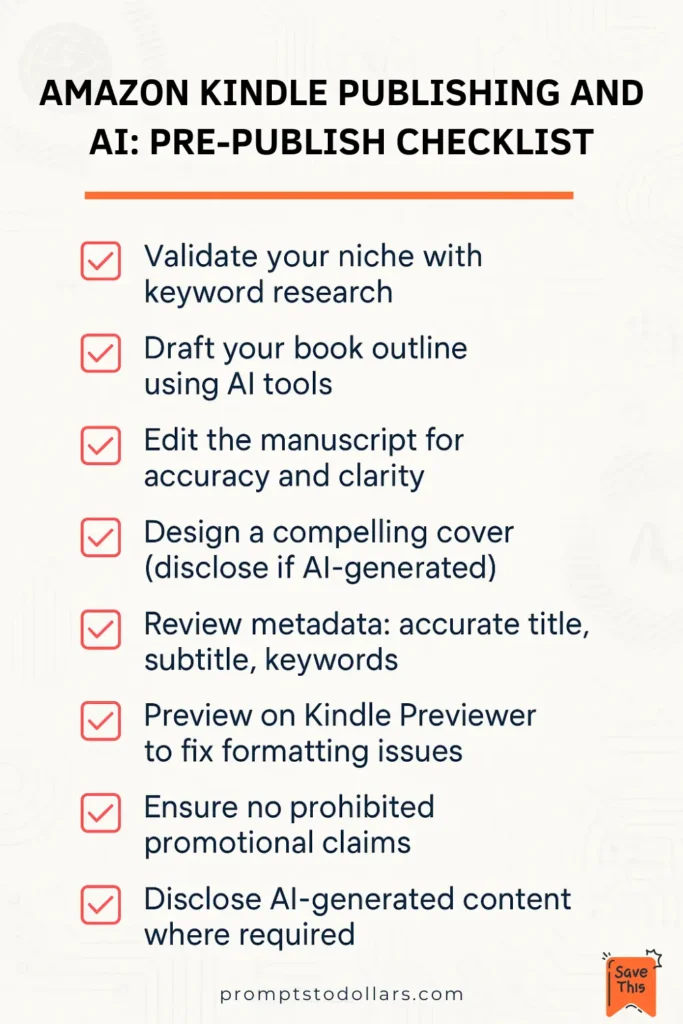
How to Use AI to 10X your Amazon Kindle Store Sales Without Breaking Rules
If you want to make money with AI, Amazon Kindle is one of the fastest ways to turn ideas into income. AI tools can help you research topics, outline chapters, polish prose, draft marketing copy, and even brainstorm cover concepts.
Yet there is a catch. If you misuse AI, ignore metadata rules, or publish low-quality files, your listings can be taken down and your account can be at risk. Amazon allows AI, but you must follow its policies and keep quality high. KDP requires you to inform them when AI-generated text, images (including covers), or translations are used; AI-assisted editing and brainstorming do not require disclosure. You also remain responsible for rights and accuracy.
In this blog, you will find a practical system you can use today to build a list and promote Amazon Kindle Store eBooks and other products with AI safely and effectively.
Playbook for the Amazon Kindle Store: AI-Generated vs. AI-Assisted
AI-generated means an AI tool created the text, images, or translation that appears in your book or cover. You must answer Yes to KDP’s AI disclosure during publishing or when you update the book later.
AI-assisted means you wrote the content and used AI to edit, refine, brainstorm, or error-check it. You do not need to disclose AI-assisted help. In both cases, you are fully responsible for intellectual property and quality.
What this means for you
- If you keep AI-written paragraphs, disclose.
- If your cover uses AI art, disclose.
- If AI just fixes grammar or suggests ideas, no disclosure required.
Following this keeps your Amazon Kindle store’s account and catalog compliant while you make money online with AI.
8 Steps to Publish and Grow on the Amazon Kindle Store with AI
Step 1: Validate Demand for Your Niche
Start by mapping audience demand so you write for a hungry market. Scan Amazon search suggestions and book reviews to collect pain points, objections, and recurring terms. Then build a short list of keywords and categories that honestly reflect your book. KDP provides explicit guidance for titles, subtitles, keywords, and categories. Your cover and metadata must match the content, avoid trademarked names and misleading phrasing, and never stuff keywords.
Quick checklist
- Keep your title + subtitle under 200 characters and aligned with your cover.
- Focus the description on the book’s content. Avoid URLs and promotional claims.
- Choose accurate categories that reflect what the book readers will get.
Step 2: Outline with AI, Write Like a Human
Use AI tools to turn reader pains into a clean outline. Ask for chapter beats, section objectives, examples, and callouts. Then write in your voice. If you paste in AI text and keep it, that is AI-generated and must be disclosed. If you draft the passage yourself and use AI as an editor, it is AI-assisted and does not require disclosure.
>> Tip: Keep a “source of truth” doc with references, quotes, and any permissions. You are responsible for rights and accuracy.
Step 3: Edit for Clarity, Accuracy, and Originality
AI can miss nuance or invent facts. Run a human pass for claims, numbers, quotes, and any step-by-step instructions before your Amazon Kindle store upload. Format the manuscript to Kindle specs and preview it on multiple devices. The Kindle Publishing Guidelines and the Guide to Kindle Content Quality explain formatting standards and the kinds of issues that trigger warnings or removal.
Quality risks that hurt sales and trust
- Broken links, missing images, or poor layout.
- Misleading detail pages or descriptions that don’t match the interior.
- Unreadable tables or images on mobile.
Amazon monitors quality and lists issues in your Quality Notifications Dashboard so you can fix them fast.
Step 4: Design a Scroll-Stopping Cover (and Disclose AI Art)
Covers sell curiosity. Use AI tools for concept exploration and mood boards, then finalize in your design app. If any cover element is AI-generated, disclose it during setup. Make sure your cover matches the metadata and does not imitate another author’s branding.
Add A+ Content (“From the Publisher”) after launch to boost conversion with annotated interior shots, feature callouts, and a short author story. Do not include customer reviews, time-sensitive promos, or “buy now” language in A+. Follow KDP’s A+ guidelines.
Step 5: Build a Clean, Compliant Amazon Kindle Store Product Page
Your product page is where readers decide. Follow KDP’s metadata rules closely:
- Title & subtitle: Match the cover and the book. No hype like “bestseller,” no competitor names, and no keyword padding.
- Description: Focus on what is inside the book. Avoid external links, review quotes, or requests for reviews.
- Keywords: Choose seven relevant phrases that capture topics, audience, and format. Keep them honest and aligned with your content.
Simple framework for descriptions
Hook with the value in one sentence. List the outcomes readers will get. Add a short preview of chapters. Close with an invitation to start reading today.
This keeps the focus on the book, not on promotions. Exactly what KDP asks for.
Step 6: Price, Royalties, and Kindle Unlimited
Amazon KDP offers 35% and 70% royalty options for eBooks, each with clear requirements and territory rules. Public-domain-primary books are only eligible for 35%. If your eBook is in Kindle Unlimited, royalties are based on pages read from the monthly Select Global Fund.
Review KDP’s pricing and royalty pages before you set your list price.
Step 7: Launch With A+ Content and Ads That Match Your Page
Once your metadata and images are clean, add A+ Content modules that address objections and preview value. Then use Amazon Ads to reach likely buyers. Amazon’s book advertising and ad-creative rules emphasize clear, accurate messaging that matches the landing page.
Avoid hype or claims you cannot substantiate.
Starter plan
- Run an automatic campaign for data.
- Harvest converting search terms and ASINs.
- Build manual keyword and product campaigns from winners.
- Track CTR (Click-Through Rate), CPC (Cost-Per-Click), and ACOS (Advertising Cost of Sales) and pause what is not working. (Amazon’s creative guides also recommend high-quality images and clear, benefit-led copy.)
Step 8: Stay Compliant on Reviews, Public Domain, and IP
Reviews: The FTC’s final rule bans fake or purchased reviews and empowers the agency to seek civil penalties. Never generate or buy reviews with AI. Build a launch team and let genuine readers post honest feedback.
Public domain: Amazon restricts undifferentiated public-domain uploads and may request proof. If your book is primarily public domain, you are limited to the 35% royalty option.
Intellectual property: You must hold rights to everything you upload. Infringing or non-exclusive content can be rejected and harm your account.
Copyright and AI: In the United States, copyright protection requires human authorship. If you later register your book, disclose any AI-generated portions, and claim protection for your human creative contributions.
Staying compliant protects your Amazon Kindle store account and long-term earnings.
READ MORE: 10 Proven Solo Business Ideas to Make Money Online This Weekend with ChatGPT at $0 Budget
Tools to Consider for a Smarter Amazon Kindle Store Workflow
Using AI effectively is not about finding one magic tool. It is about building a “stack” of smart assistants that streamline each part of your publishing process. Here are the key categories and examples of tools that can help you work faster and smarter.
1. Niche and Keyword Research Helpers
Before you write a single word, you need to know what readers are looking for. AI can supercharge this process by analyzing market data to find profitable, low-competition opportunities.
- What they do: Identify high-demand, low-competition keywords; analyze competitor performance; and suggest untapped niches for your next book.
- Example of tools to consider: Book Bolt, Perplexity, ChatGPT, Claude, Gemini.
2. Writing and Editing AI Assistants
These AI tools act as your creative partner and quality control specialist. They can help you structure your book, generate initial drafts, and polish your own writing to a professional standard.
- What they do: Brainstorm and outline chapters; draft text (which is AI-generated and requires disclosure); and refine your own writing for grammar, style, and clarity (which is AI-assisted).
- Example of AI tools to consider: Stealthwriter.ai, Grammarly, Writesonic, ChatGPT, Claude, or Gemini.
3. Cover Design and Layout Tools
A book’s cover is its most important marketing asset. AI can help you create stunning, professional-grade visuals without needing to be a graphic designer.
- What they do: Generate unique images for covers and interior graphics; create mockups for A+ Content modules.
- Example of tools to consider:
- Midjourney, ChatGPT Image Generator, Adobe Firefly, Ideogram, Lovart.ai for covers and concepts, then finish in Canva/Photoshop.
- Kindle Create, Atticus, Vellum, or Canvafor interior and formatting.
4. Advertising and Marketing Support
Once your book is published, AI can help you create and optimize your Amazon Ads campaigns to reach more readers.
- What they do: Draft compelling ad copy; generate lists of relevant keywords to target; and identify competitor ASINs to target with your ads.
- Example tools to consider:
- Helium 10andTeikametricsoffer a range of features, from ad management to market research.
- Amazon’s AI Creative Studio, ChatGPT.
Common Mistakes That Kill Momentum
Publishing on KDP is a marathon, not a sprint. While you can use AI tools to speed things up, a few common and easily avoidable mistakes can bring your progress to a screeching halt. Here’s what to watch out for:
- Misleading or stuffed metadata that promises what the interior does not deliver. Your metadata must be an honest and accurate representation of your book.
- Skipping the preview step and publishing with glaring formatting errors, like inconsistent fonts, weird spacing, or unreadable text. Always use the Kindle Previewer tool before you hit publish to see exactly how your book will look on different devices and fix any issues.
- Using review quotes in descriptions or adding promo language like review quotes (even good ones), external links or URLs, or requests for reviews in your book description. Likewise, your A+ Content has its own set of rules and cannot contain promotional language or time-sensitive claims.
- Assuming AI text is “good enough.” Raw AI writing often lacks depth, contains factual errors (“hallucinations”), and reads like it was written by a machine. Your readers are smart, and they can spot low-effort content from a mile away. You must always act as the editor-in-chief, applying a thorough human review to fact-check, refine, and add your unique voice.
Do I Need to Disclose use of AI?
To publish successfully with AI on Amazon KDP, you must understand one core principle. While Amazon allows you to use AI tools, you are required to inform KDP if your book contains any text, images, or translations that were created by an AI. KDP defines this as “AI-generated” content.
However, if you only used AI to help edit or brainstorm ideas while writing the final words or creating the final image yourself, that is considered “AI-assisted” and does not need to be disclosed.
In either scenario, you remain fully responsible for ensuring the final work is high-quality and respects all intellectual property rights.
Where the question appears:
During title setup, Amazon KDP asks whether the book contains AI-generated content. The same requirement applies when you republish updates.
FYI: As reported by AP and the Authors Guild, Amazon currently gathers this disclosure for policy enforcement, and it is not shown to customers at purchase time.
The Flowchart for your Amazon Kindle Store(simple yes/no path)
Start → Are you including anything on your product page or inside the file that was created by an AI tool?
Examples: chapters, summaries, blurbs, interior art, the cover image, or a machine translation.
- If YES →
- Is it text, an image/cover, or a translation that the AI produced and you kept?
• Yes → Disclose “AI-generated” in KDP.
• Also do this: verify rights, run a human edit, and meet all KDP quality and metadata rules.
- Is it text, an image/cover, or a translation that the AI produced and you kept?
- If NO →
- Did AI only assist you (such as spell-checking, re-ordering your own sentences, brainstorming outline ideas, image retouching on your original photo)?
• Yes → No disclosure required (that is, AI-assisted). Keep records of what you did and still follow all quality and IP rules.
• No → proceed as normal, but review metadata and quality guidelines before you publish.
- Did AI only assist you (such as spell-checking, re-ordering your own sentences, brainstorming outline ideas, image retouching on your original photo)?
Common Scenarios: When to Click “Yes” or “No” on Disclosure
| Situation in your workflow | What it is under KDP’s definitions | Disclose? |
|---|---|---|
| You paste AI-written paragraphs into your manuscript and keep them (even after editing). | AI-generated text | Yes. |
| You use a paraphrasing/summarizing tool and keep the tool’s new wording for your description or back-cover copy. | New AI-generated text kept in the book/listing | Yes. (Falls under “text created by an AI tool.”) |
| Your cover art was created with an AI image generator like Midjourney or Stable Diffusion. | AI-generated image/cover | Yes. |
| You use a machine or AI translation service (like Google Translate or DeepL) to translate your book and publish that output. | AI-generated translation | Yes. |
| You write the draft yourself and use an AI tool like Grammarly to check for spelling and grammar. | AI-assisted (editing/brainstorming only) | No. |
| You use an AI tool to brainstorm plot ideas or chapter titles, but you write the actual content yourself. | AI-assisted (editing/brainstorming) | No. |
| A professional human translator uses AI-assisted tools to ensure consistency, but delivers a human-led translation. | AI-assisted | No. (Confirm rights and quality.) |
| You design the cover from stock photos you licensed and edit yourself; no AI art used. | Not AI-generated | No. (Still follow KDP’s cover specs and rights rules.) |
Mini Checklist Before You Publish to the Amazon Kindle Store
- Disclosure: If any AI-generated text, images/cover, or translations remain in the file or detail page, select Yes to the AI question in KDP.
- Metadata: Titles, subtitles, keywords, and descriptions must be accurate and non-misleading. Avoid review quotes, URLs, competitor names, or keyword stuffing.
- Quality: Run Kindle Previewer and fix formatting or readability issues. Monitor the Quality Notifications dashboard after launch.
Wrap Up
You can make money with AI by using it to speed up research, drafting, covers, and ads. The key is to protect trust. Follow these Amazon Kindle store’s AI disclosure rules, keep metadata clean and honest, preview your files, and stay on the right side of review and copyright policies. When your KDP eBooks are accurate, well-formatted, and clearly presented, AI becomes a safe multiplier and not a risk.
Next step: Pick a niche, draft your outlines with AI, and use the checklist in the image below before you hit Publish.
Frequently Asked Questions (FAQs)
Can you use AI to write books for the Amazon Kindle Store?
Yes, you can absolutely sell books written by AI on Amazon, provided you follow the rules and regulations. To do so successfully, you must disclose the use of AI-generated content to KDP, ensure the final manuscript is heavily edited for quality and originality, and make sure your book complies with all of Amazon’s policies, including those related to copyright and metadata. A book won’t be rejected just for using AI, but it can be removed for being low-quality or violating guidelines.
Do I have to disclose Grammarly or an AI grammar checker?
No. Editing, refining, or brainstorming is AI-assisted and does not require disclosure. Disclose only AI-generated text, images, or translations you keep.
Can I paste review quotes into my book description?
No. KDP’s metadata rules prohibit review quotes and requests for reviews in descriptions. Keep the description focused on the book’s content.
Is AI cover art allowed in the Amazon Kindle Store?
Yes, but you must disclose it during setup and follow A+ Content rules if you showcase the art below the fold.
What royalty should I expect?
Most Kindle eBooks are eligible for 35% or 70% royalties based on list price and territory rules. Public-domain-primary titles are limited to 35%.
How does Kindle Unlimited pay?
Kindle Unlimited pays from a monthly fund based on the number of pages read (KENP). It is separate from your retail royalties.



